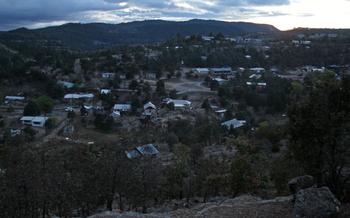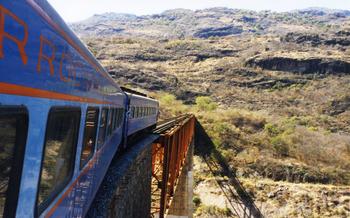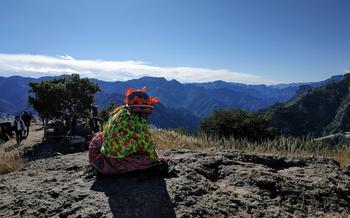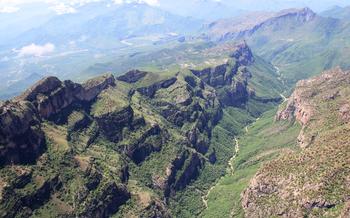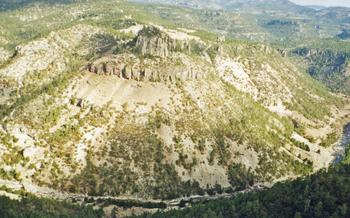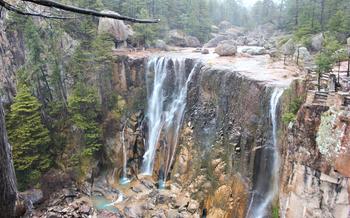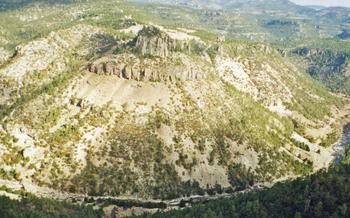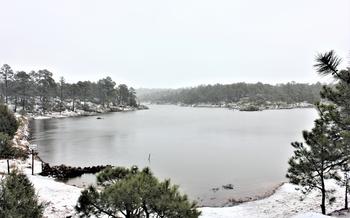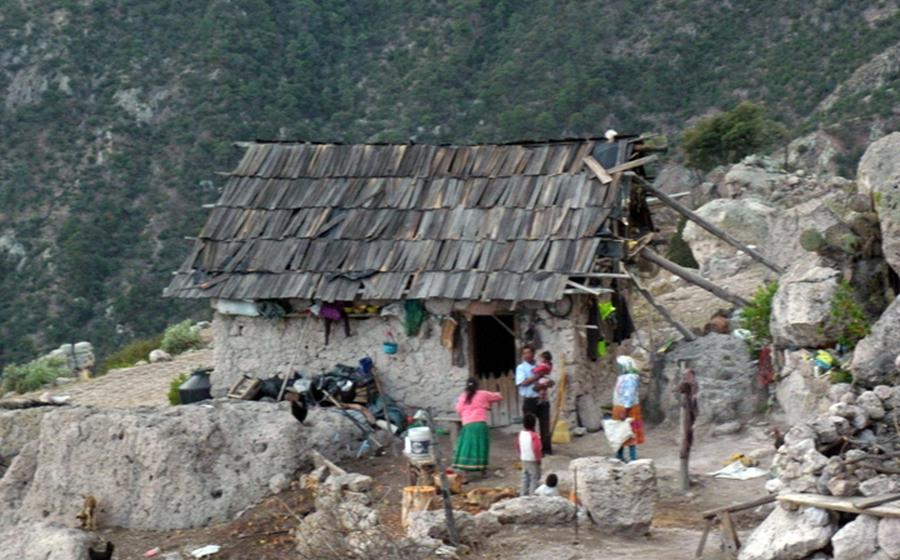
Santa Rosalia de Cuevas
- Historical Background
- Geographic Setting
- Getting to Santa Rosalia de Cuevas
- Accommodation Options
- Dining in Santa Rosalia de Cuevas
- Exploring the Town of Santa Rosalia de Cuevas
- Visit the Copper Mines
- Hike the Copper Canyon
- Horseback Riding Adventures
- Experience the Tarahumara Culture
- Visit the Miradores
- Take a Copper Canyon Train Ride
- Insider Tip: Best Time to Visit
Historical Background
The region of Copper Canyon has a rich history that dates back to pre-Columbian times. The area was inhabited by various indigenous civilizations, including the Tarahumara, who have lived in the region for over thousands of years. They had a strong connection to the land and were skilled in mining and agriculture.
During the 16th century, Spanish conquistadors arrived in the region and established mining operations in the canyons. The Spanish were drawn to the area by the abundant copper deposits, which were used to produce weapons and other goods. The mining industry boomed in the 19th century, and the region became known as the Copper Canyon. Mining towns such as Santa Rosalia de Cuevas were established, and the population of the region grew rapidly.
In the 20th century, the mining industry declined, and the region fell into economic decline. However, in recent years, there has been a renewed interest in the Copper Canyon as a tourist destination. Visitors come to the region to experience the stunning scenery, explore the history and culture of the region, and enjoy outdoor activities such as hiking, horseback riding, and white-water rafting.
Geographic Setting
The Copper Canyon is a network of canyons located in the southwestern part of the state of Chihuahua, in Mexico. It is part of the Sierra Madre Occidental, a vast mountain range that extends from the United States to Central America. The canyon system is formed by the Rio Fuerte River and its tributaries, which have carved deep gorges into the mountains over millions of years.
The Copper Canyon is often compared to the Grand Canyon in the United States, but it is actually much larger. It covers an area of over 25,000 square miles (65,000 square kilometers), and its deepest point is over 1,800 meters (6,000 feet) deep. The canyon walls are steep and rugged, and the terrain is often difficult to navigate.
The Rio Fuerte River is the lifeblood of the Copper Canyon. It provides water for irrigation and drinking, and it also supports a variety of fish and wildlife. The river is also a popular destination for white-water rafting and kayaking.
The Copper Canyon is home to a variety of indigenous cultures, including the Tarahumara, who have lived in the region for centuries. The Tarahumara are known for their traditional way of life, which includes farming, hunting, and gathering. They are also skilled weavers and potters.
Getting to Santa Rosalia de Cuevas
Accessing Santa Rosalia de Cuevas presents a blend of challenges and opportunities. Driving your vehicle offers the freedom to explore the region at your own pace, allowing for spontaneous stops and detours. However, be prepared for rugged and winding roads that demand a sturdy vehicle and experienced driving skills. Public transportation, though limited, provides a budget-friendly option for those seeking a more relaxed journey. Buses run from larger cities like Chihuahua or Los Mochis, offering scenic routes that showcase the region's diverse landscapes.
Despite its remote location, Santa Rosalia de Cuevas is accessible to travelers with a thirst for adventure. Once you reach the town, the compact size and friendly atmosphere make it easy to navigate. However, the challenges of remoteness should not be overlooked. Limited access to amenities and services, fluctuating weather conditions, and potential language barriers require a degree of adaptability and flexibility. Embrace the challenges as part of the adventure, and you'll be rewarded with an authentic and immersive experience in the heart of the Copper Canyon.
Accommodation Options
Lodging in Santa Rosalia de Cuevas offers a range of options to suit various budgets and preferences. For backpackers and budget-conscious travelers, hostels and guesthouses provide a comfortable and affordable stay. These accommodations often feature shared dormitories, common areas, and basic amenities.
Mid-range hotels offer a step up in comfort and amenities, with private rooms, en-suite bathrooms, and additional facilities such as swimming pools or restaurants. For a truly immersive experience, consider staying in a traditional Mexican hacienda, which often blends rustic charm with modern conveniences.
Booking your accommodation in advance, especially during peak tourist season, is recommended to secure your desired option. Online platforms and local travel agencies offer convenient booking services, allowing you to compare prices, read reviews, and make reservations from the comfort of your home.
Dining in Santa Rosalia de Cuevas
Local Cuisine and Dishes Santa Rosalia de Cuevas offers a culinary journey that celebrates the region's rich cultural heritage. The local cuisine is heavily influenced by indigenous traditions and fresh, locally sourced ingredients. Try the mouthwatering caldo de queso, a hearty cheese soup with tender chunks of cheese and corn, or indulge in enchiladas mineras, a traditional dish of corn tortillas filled with cheese, potatoes, and topped with a flavorful red chili sauce. Don't miss the orejones, dried peaches that are a local specialty and a sweet treat to savor.
Traditional Restaurants The town's charming streets are lined with traditional restaurants that offer a warm and inviting ambiance. Immerse yourself in the local culture as you dine at family-run establishments that have been passed down through generations. Taste the authentic flavors of the region at El Rinconcito, a cozy restaurant known for its generous portions and home-style cooking. For a special occasion, visit La Casona, a beautifully restored colonial mansion that offers fine dining with a modern twist, showcasing the region's culinary artistry.
Markets and Food Stalls Experience the vibrant culinary scene of Santa Rosalia de Cuevas by visiting the local markets and food stalls. The bustling Mercado Municipal is a must-visit, where you can find an array of fresh fruits, vegetables, spices, and local delicacies. Sample traditional street food such as tacos al pastor, succulent pork tacos with grilled pineapple, or quesadillas, grilled tortillas filled with cheese and your choice of fillings. Don't forget to try the refreshing agua fresca, a fruit-infused water that is a popular thirst quencher.
Vegetarian and Vegan Options While the local cuisine is predominantly meat-based, there are several options for vegetarians and vegans. Many restaurants offer variations of traditional dishes using plant-based ingredients, such as enchiladas de huitlacoche, corn tortillas filled with a flavorful mushroom filling. Look for restaurants that display the "Vegetariano" or "Vegano" signs to easily identify vegetarian and vegan-friendly establishments.
Exploring the Town of Santa Rosalia de Cuevas
Main Landmarks and Historical Sites:
Strolling through the streets of Santa Rosalia de Cuevas, one is greeted by an array of significant landmarks and historical sites that narrate the town's rich past. The Parroquia de Santa Rosalia, a majestic church, stands as a testament to the town's religious devotion, its intricate architecture reflecting the fusion of Spanish and indigenous influences. The Museo Comunitario, a community museum, houses a collection of artifacts and exhibits that provide insights into the region's history and culture, including the fascinating story of copper mining. For those seeking a deeper connection with nature, the Parque Ecoturistico Barrancas del Cobre offers breathtaking views of the surrounding canyons and opportunities for hiking and birdwatching.
Walking Tours: Exploring the Streets:
The best way to immerse oneself in the charm of Santa Rosalia de Cuevas is to embark on a leisurely walking tour, allowing the town's vibrant streets to unravel their secrets. Admire the colorful murals adorning the walls, depicting scenes from local life and the region's history. Engage with friendly locals, who are always eager to share stories and anecdotes about their beloved town. Discover hidden plazas, charming cafes, and local markets, where one can savor the flavors of traditional Mexican cuisine and pick up unique souvenirs.
Museums: Cultural Heritage Discoveries:
Santa Rosalia de Cuevas is home to several museums that offer a glimpse into the town's cultural heritage. The Museo Comunitario showcases a collection of artifacts and exhibits that narrate the town's history, from its pre-Columbian roots to its role in the copper mining industry. The Museo de las Culturas Populares del Estado de Chihuahua displays traditional crafts and artwork from the region, highlighting the vibrant cultural traditions of the indigenous communities. These museums provide a deeper understanding of the town's identity and its place within the broader context of Mexican culture.
Visit the Copper Mines
The mining legacy of Santa Rosalia de Cuevas is deeply intertwined with the history and culture of the town. Copper mining has been a significant economic activity in the region for centuries, shaping the lives and livelihoods of its inhabitants.
Guided tours are available for visitors who wish to explore the underground mines and gain insights into the mining processes and techniques used in the past. These tours offer a unique opportunity to witness the remnants of a bygone era and appreciate the hard work and dedication of the miners who once toiled in these mines.
Safety measures are strictly enforced to ensure the well-being of visitors during mine tours. Helmets and protective gear are provided, and experienced guides lead the tours, explaining the history and geology of the mines and ensuring the safety of all participants.
Hike the Copper Canyon
The Copper Canyon offers a network of scenic trails and routes for hiking enthusiasts of all levels. Whether you're an experienced trekker or a beginner seeking a leisurely stroll, the canyon has something for everyone. The trails traverse diverse landscapes, from lush forests and rugged cliffs to meandering rivers and cascading waterfalls.
Difficulty Levels Hikers can choose from various difficulty levels depending on their experience and fitness level. Easy trails are suitable for families with young children, while intermediate trails offer a more challenging but still manageable experience. Advanced trails, on the other hand, are recommended for seasoned hikers who enjoy strenuous treks with steep inclines and rugged terrain.
Essential Gear and Equipment Before embarking on a hiking adventure in the Copper Canyon, it's crucial to pack the necessary gear and equipment. Comfortable hiking boots or shoes are essential to ensure good traction and support on uneven surfaces. Additionally, bring layers of clothing to adapt to changing weather conditions, as temperatures can fluctuate significantly throughout the day. Don't forget essentials like a hat, sunglasses, and sunscreen to protect yourself from the sun. A water bottle and snacks are also vital to stay hydrated and energized during your hike.
Horseback Riding Adventures
Embark on an unforgettable equestrian adventure through the awe-inspiring landscapes of Copper Canyon. Discover hidden trails, traverse rugged terrains, and witness breathtaking panoramas from atop a majestic steed. Guided tours led by experienced local guides ensure a safe and enriching experience, allowing you to immerse yourself in the natural beauty and rich cultural heritage of the region.
As you ride through the canyons, marvel at the towering cliffs, cascading waterfalls, and lush vegetation that surround you. Breathe in the fresh mountain air and feel the exhilaration of exploring this natural paradise on horseback. Whether you're a seasoned rider or a novice, there's a trail to suit your skill level.
For those seeking a leisurely experience, gentle trails meander through picturesque valleys, offering panoramic views of the canyons. For the more adventurous, challenging trails lead to hidden waterfalls, remote viewpoints, and ancient rock formations.
Don't miss the opportunity to witness the sunset over the canyons from the back of a horse. As the sky transforms into a canvas of vibrant colors, the canyons take on a magical aura, creating a moment that will stay with you long after your visit.
Experience the Tarahumara Culture
The Tarahumara, also known as the Rarámuri, are an indigenous people who have called the Copper Canyon region their home for centuries. They have a rich and vibrant culture that is deeply intertwined with the land and its traditions. Visiting Santa Rosalia de Cuevas provides an opportunity to immerse yourself in the Tarahumara way of life and gain insights into their unique heritage.
The Rarámuri are renowned for their incredible running abilities and their deep connection to nature. They are often seen running long distances in their traditional attire, demonstrating their endurance and resilience. Visitors can learn about their running traditions and witness their awe-inspiring feats of athleticism.
Cultural festivals and celebrations are an integral part of Tarahumara life. These events showcase their traditional music, dance, and crafts. Visitors can attend these festivals to experience the vibrant energy and colorful costumes of the Rarámuri people.
Exploring the Tarahumara culture also means discovering their intricate handicrafts. They are skilled weavers, potters, and woodworkers, creating beautiful and functional items that reflect their cultural identity. Visitors can purchase these handicrafts as souvenirs to support the local economy and take home a piece of the Tarahumara heritage.
Interacting with the Tarahumara people is an enriching experience that allows travelers to gain a deeper understanding of their way of life. Their warm hospitality and willingness to share their culture create a unique and memorable encounter for visitors.
Visit the Miradores
Copper Canyon's impressive vistas and landscapes can be admired from various vantage points known as miradores. These platforms offer panoramic views that showcase the vastness and rugged beauty of the canyons.
Popular viewing platforms include the Mirador de los Monjes, providing sweeping views of the Urique Canyon, and the Mirador de la Barranca del Cobre, which offers a bird's-eye perspective of the Rio Fuerte canyon and the surrounding peaks.
A visit to the miradores is a must for photography enthusiasts and nature lovers, who can capture breathtaking images of the canyons, cliffs, and distant mountains. The play of light and shadows as the sun moves across the sky creates ever-changing vistas that are a delight to behold.
Remember to bring a camera with a good lens to capture the stunning beauty of the canyons from these vantage points. A pair of binoculars can also enhance your viewing experience, allowing you to observe the diverse flora and fauna that inhabit these ecosystems.
Take a Copper Canyon Train Ride
El Chepe, the Chihuahua al Pacifico, is one of the most iconic train rides in the world, and it runs right through the heart of the Copper Canyon. The train journey offers breathtaking sights and landscapes, taking you through tunnels, over bridges, and alongside sheer cliffs. Along the way, you'll pass through several small towns and villages, where you can hop off to explore and interact with the local communities. The train ride is a great way to see the canyon from a different perspective and to experience the region's rich culture and history. It's a must-do for anyone visiting the Copper Canyon.
If you're planning to take the train, be sure to book your tickets in advance, especially if you're traveling during the peak tourist season. You can choose from different classes of service, including first-class with panoramic windows and meals included. The train journey takes about 15 hours, but it's well worth it for the incredible views and experiences you'll have along the way.
Insider Tip: Best Time to Visit
Timing is everything, especially when planning a trip to Copper Canyon. The ideal time to visit this majestic region is during the dry season, which runs from November to April. During these months, the weather is at its best, with warm and sunny days and cool nights. The skies are clear, offering stunning views of the canyons and surrounding landscapes.
While the dry season is generally considered the best time to visit, it's important to note that the peak tourist season falls during the Christmas and Easter holidays. During these periods, the region experiences an influx of visitors, and prices for accommodations and tours may be higher. If you prefer a more tranquil experience and want to avoid the crowds, consider visiting during the shoulder months (May, June, September, and October). The weather is still favorable during these months, with occasional rain showers adding a refreshing touch to the landscape.
No matter when you choose to visit Copper Canyon, be sure to come prepared for all types of weather conditions. Even during the dry season, temperatures can fluctuate, so pack layers of clothing to adjust to the changing climate. And don't forget your sunscreen, sunglasses, and a hat to protect yourself from the strong sun.
